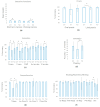A Longitudinal Multimodal Imaging Study in Patients with Temporo-Insular Diffuse Low-Grade Tumors: How the Inferior Fronto-Occipital Fasciculus Provides Information on Cognitive Outcomes
- PMID: 39727718
- PMCID: PMC11674248
- DOI: 10.3390/curroncol31120595
A Longitudinal Multimodal Imaging Study in Patients with Temporo-Insular Diffuse Low-Grade Tumors: How the Inferior Fronto-Occipital Fasciculus Provides Information on Cognitive Outcomes
Abstract
Background: Tractography allows the in vivo study of subcortical white matter, and it is a potential tool for providing predictive indices on post-operative outcomes. We aim at establishing whether there is a relation between cognitive outcome and the status of the inferior fronto-occipital fasciculus's (IFOF's) microstructure.
Methods: The longitudinal neuropsychological data of thirty young (median age: 35 years) patients operated on for DLGG in the left temporo-insular cortex along with pre-surgery tractography data were processed.
Results: A degraded integrity of the left (vs. right) IFOF (lower fractional anisotropy and length, p < 0.001; higher mean and axial diffusivity, p < 0.01) was found, with lower microstructural variables in the infiltration (vs. dislocation) group. Significant decreases immediately post-surgery vs. pre-surgery mainly occurred in lexico-semantics (p < 0.001), with significant improvements at follow-up in all the tests (p < 0.01 to p < 0.001), despite values in the range of 44% to 47.82% of patients with below cut-off scores regarding naming verbs and making visual lexical decisions. The status of left and right IFOFs is predictive of a decrease in immediate post-surgery performance for several tests (p < 0.05); similarly, it is predictive of better recovery in the follow-up performance for naming nouns, naming verbs, making phonological fluency lexical decisions, and the token test (p < -0.05). For the ROC analysis, a significant result was obtained for the verb-naming test, with a cut-off of 79%.
Conclusions: This study supports the role of the predictive value of pre-operative tractography for assessing the immediate post-operative result and at follow-up the risk of developing a cognitive deficit.
Keywords: fiber tracking; inferior fronto-occipital fasciculus; lower-grade gliomas; microstructure analysis; neuropsychology; predictive value.
Conflict of interest statement
The authors declare no conflicts of interest.
Figures





Similar articles
-
Deficits in naming pictures of objects are associated with glioma infiltration of the inferior longitudinal fasciculus: A study with diffusion MRI tractography, volumetric MRI, and neuropsychology.Hum Brain Mapp. 2023 Jul;44(10):4011-4027. doi: 10.1002/hbm.26325. Epub 2023 May 5. Hum Brain Mapp. 2023. PMID: 37145980 Free PMC article.
-
Diffuse alterations in grey and white matter associated with cognitive impairment in Shwachman-Diamond syndrome: evidence from a multimodal approach.Neuroimage Clin. 2015 Feb 27;7:721-31. doi: 10.1016/j.nicl.2015.02.014. eCollection 2015. Neuroimage Clin. 2015. PMID: 25844324 Free PMC article.
-
Microstructural Injury to Left-Sided Perisylvian White Matter Predicts Language Decline After Brain Radiation Therapy.Int J Radiat Oncol Biol Phys. 2020 Dec 1;108(5):1218-1228. doi: 10.1016/j.ijrobp.2020.07.032. Epub 2020 Jul 23. Int J Radiat Oncol Biol Phys. 2020. PMID: 32712255 Free PMC article.
-
Dissociations in white matter tracts and neuropsychological findings in a 17 years old patient with Subacute sclerosing panencephalitis.Brain Cogn. 2023 Feb;165:105941. doi: 10.1016/j.bandc.2022.105941. Epub 2022 Dec 24. Brain Cogn. 2023. PMID: 36571871 Review.
-
Tractography and the connectome in neurosurgical treatment of gliomas: the premise, the progress, and the potential.Neurosurg Focus. 2020 Feb 1;48(2):E6. doi: 10.3171/2019.11.FOCUS19785. Neurosurg Focus. 2020. PMID: 32006950 Free PMC article. Review.
Cited by
-
From classic models to new pathways: unraveling the anatomy and function of the inferior fronto-occipital fasciculus in language processing.Front Psychol. 2025 Apr 2;16:1561482. doi: 10.3389/fpsyg.2025.1561482. eCollection 2025. Front Psychol. 2025. PMID: 40242731 Free PMC article.
References
-
- Skrap M., Mondani M., Tomasino B., Weis L., Budai R., Pauletto G., Eleopra R., Fadiga L., Ius T. Surgery of insular nonenhancing gliomas: Volumetric analysis of tumoral resection, clinical outcome, and survival in a consecutive series of 66 cases. Neurosurgery. 2012;70:1081–1093; discussion 1093–1094. doi: 10.1227/NEU.0b013e31823f5be5. - DOI - PubMed
-
- Martino J., Mato D., de Lucas E.M., García-Porrero J.A., Gabarrós A., Fernández-Coello A., Vázquez-Barquero A. Subcortical anatomy as an anatomical and functional landmark in insulo-opercular gliomas: Implications for surgical approach to the insular region. J. Neurosurg. 2015;123:1081–1092. doi: 10.3171/2014.11.JNS141992. - DOI - PubMed
MeSH terms
Grants and funding
LinkOut - more resources
Full Text Sources
Medical

